Experimental Study on the Mechanical Properties of Perfobond Rib Shear Connectors with Steel Fiber High Strength Concrete
Abstract
1. Introduction
2. Experimental Program
2.1. Specimen Design
2.2. Loading Setup and Measuring System
3. Analysis of Test Results
3.1. Damage and Failure Modes
3.2. Load-Slip Curves
3.3. Results Analysis
3.3.1. Influence of Concrete Strength
3.3.2. Influence of Diameter of Penetrating Rebar
3.3.3. Influence of Number of Holes
4. Shear Capacity Equation for PBL Connectors
4.1. Existing Shear Capacity Equations for PBL Connectors
4.2. Composition of Shear Capacity for PBL Connectors
4.2.1. Contribution of Concrete Dowels
4.2.2. Contribution of Concrete End-Bearing
4.2.3. Contribution of Interface Bond
4.2.4. Contribution of Penetrating Rebar
4.3. Establishment and Validation of Shear Capacity Equation
5. Conclusions
- (1)
- PBL connectors employing SFHSC primarily experience one or more of the failure modes of concrete dowel crushing, penetration reinforcement fracture and steel plate yielding, while essentially no severe cracking of the concrete slab occurs, which may appear in the PBL connectors employing conventional concrete. Moreover, as shear failure of the penetrating reinforcement occurs, it is often accompanied by failure of the concrete dowel. The full load carrying capacity of the member that does not fail is not fully utilized when the connector fails, and the desirable design is that the concrete dowel, the penetrating rebars, the steel plate and the concrete slab all achieve their full load carrying capacity.
- (2)
- The shear capacity of PBL connectors increases with the increase in concrete strength, diameter of penetrating reinforcement and number of holes and the influence degree of the change in the number of holes is the most significant. In the design, the increase of these parameters is effective in increasing the shear capacity of the connectors. The continuous growth of these parameters cannot bring a constant and significant increase in the shear capacity of PBL connectors, and the mutual adaptation of the parameters of PBL connectors should be ensured in the design process. Additionally, the random distribution of steel fibers in concrete can effectively inhibit the expansion of old cracks and the formation of new cracks, and then enhance the ductility and shear capacity of the specimens.
- (3)
- One general prediction formula for the shear capacity of PBL connectors was established based on regression analysis of test data. The proposed formula accounts for the contribution of concrete dowels, concrete end-bearing, interface bond between perforated steel plates and concrete and penetrating rebars to the shear capacity of the PBL connectors, as well as the reinforcing effect of the steel fibers on the material properties. The comparison of the prediction results obtained using the proposed formula with the experimental results demonstrates the excellent accuracy and applicability of the proposed formula, which can be used for the prediction of the shear capacity and provide a reference for the design of PBL connectors.
Author Contributions
Funding
Institutional Review Board Statement
Informed Consent Statement
Data Availability Statement
Acknowledgments
Conflicts of Interest
References
- Zhu, L.; Wang, H.; Han, B.; Zhao, G.; Huo, X.; Ren, X. Dynamic analysis of a coupled steel-concrete composite box girder bridge-train system considering slip and shear-lag. Thin Wall. Struct. 2020, 157, 107060. [Google Scholar] [CrossRef]
- Zheng, S.; Liu, Y.; Liu, Y.; Zhao, C. Experimental and parametric study on the pull-out resistance of a notched perfobond shear connector. Appl. Sci. 2019, 9, 764. [Google Scholar] [CrossRef]
- Liu, R.; Zhao, H.; Feng, Z.; Xin, H.; Liu, Y. Fatigue evaluation on headed stud connectors with toe-plate failure mode using hot spot stress approach. Eng. Fail. Anal. 2020, 117, 104972. [Google Scholar] [CrossRef]
- Wang, J.; Xu, Q.; Yao, Y.; Qi, J.; Xiu, H. Static behavior of grouped large headed stud-UHPC shear connectors in composite structures. Compos. Struct. 2018, 206, 202–214. [Google Scholar] [CrossRef]
- Leonhardt, F.; Andrä, W.; Andrä, H.-P.; Harre, W. Neues, vorteilhaftes verbundmittel für stahlverbund-tragwerke mit hoher dauerfestigkeit. Beton Stahlbetonbau 1987, 82, 325–331. [Google Scholar] [CrossRef]
- Deng, W.; Xiong, Y.; Liu, D.; Zhang, J. Static and fatigue behavior of shear connectors for a steel-concrete composite girder. J. Constr. Steel Res. 2019, 159, 134–146. [Google Scholar] [CrossRef]
- Li, Z.; Zhao, C.; Deng, K.; Wang, W. Load sharing and slip distribution in multiple holes of a perfobond rib shear connector. J. Struct. Eng. 2018, 144, 04018147. [Google Scholar] [CrossRef]
- Oguejiofor, E.C.; Hosain, M.U. A parametric study of perfobond rib shear connectors. Can. J. Civ. Eng. 1994, 21, 614–625. [Google Scholar] [CrossRef]
- He, S.; Fang, Z.; Fang, Y.; Liu, M.; Liu, L.; Mosallam, A.S. Experimental study on perfobond strip connector in steel-concrete joints of hybrid bridges. J. Constr. Steel Res. 2016, 118, 169–179. [Google Scholar] [CrossRef]
- Zheng, S.; Zhao, C.; Liu, Y. Analytical model for load–slip relationship of perfobond shear connector based on push-out test. Materials 2019, 12, 29. [Google Scholar] [CrossRef]
- Zhan, Y.; Yin, C.; Liu, F.; Song, R.; Deng, K.; Sun, J. Pushout tests on headed studs and PBL shear connectors considering external pressure. J. Bridge Eng. 2020, 25, 04019112. [Google Scholar] [CrossRef]
- Shi, W.; Shafei, B.; Liu, Z.; Phares, B.M. Early-age performance of longitudinal bridge joints made with shrinkage-compensating cement concrete. Eng. Struct. 2019, 197, 109391. [Google Scholar] [CrossRef]
- Liu, Y.; Wei, Y. Effect of calcined bauxite powder or aggregate on the shrinkage properties of UHPC. Cem. Concr. Compos. 2021, 118, 103967. [Google Scholar] [CrossRef]
- Kang, J.Y.; Park, J.S.; Jung, W.T.; Keum, M.S. Evaluation of the shear strength of perfobond rib connectors in ultra high performance concrete. Eng. PRC 2014, 6, 989–999. [Google Scholar] [CrossRef]
- He, S.; Fang, Z.; Mosallam, A.S. Push-out tests for perfobond strip connectors with UHPC grout in the joints of steel-concrete hybrid bridge girders. Eng. Struct. 2017, 135, 177–190. [Google Scholar] [CrossRef]
- He, S.; Mosallam, A.S.; Fang, Z.; Zou, C.; Feng, W.; Su, J. Experimental study on CFSC encased shear connectors in steel-concrete composite joints with UHPC grout. Constr. Build. Mater. 2018, 173, 638–649. [Google Scholar] [CrossRef]
- Duan, M.; Zhang, S.; Wang, X.; Dong, F. Mechanical behavior in perfobond rib shear connector with UHPC-steel composite structure with coarse aggregate. KSCE J. Civ. Eng. 2020, 24, 1255–1267. [Google Scholar] [CrossRef]
- Zhu, Y.; Zhang, Y.; Hussein, H.H.; Liu, J.; Chen, G. Experimental study and theoretical prediction on shrinkage-induced restrained stresses in UHPC-RC composites under normal curing and steam curing. Cem. Concr. Comp. 2020, 110, 103602. [Google Scholar] [CrossRef]
- Xie, T.; Fang, C.; Ali, M.M.; Visintin, P. Characterizations of autogenous and drying shrinkage of ultra-high performance concrete (UHPC): An experimental study. Cem. Concr. Comp. 2018, 91, 156–173. [Google Scholar] [CrossRef]
- Hamoda, A.; Emara, M.; Mansour, W. Behavior of steel I-beam embedded in normal and steel fiber reinforced concrete incorporating demountable bolted connectors. Compos. Part B Eng. 2019, 174, 106996. [Google Scholar] [CrossRef]
- Zhang, Y.; Liu, A.; Chen, B.; Zhang, J.; Pi, Y.L.; Bradford, M.A. Experimental and numerical study of shear connection in composite beams of steel and steel-fibre reinforced concrete. Eng. Struct. 2020, 215, 110707. [Google Scholar] [CrossRef]
- Bajaber, M.A.; Hakeem, I.Y. UHPC evolution, development, and utilization in construction: A review. J. Mater. Res. Technol. 2021, 10, 1058–1074. [Google Scholar] [CrossRef]
- Ashkezari, G.D.; Fotouhi, F.; Razmara, M. Experimental relationships between steel fiber volume fraction and mechanical properties of ultra-high performance fiber-reinforced concrete. J. Build. Eng. 2020, 32, 101613. [Google Scholar] [CrossRef]
- Zhang, J.; Liu, J.; Li, X.; Cao, W. Seismic behavior of steel fiber-reinforced high-strength concrete mid-rise shear walls with high-strength steel rebar. J. Build. Eng. 2021, 42, 102462. [Google Scholar] [CrossRef]
- Kim, S.-H.; Kim, K.-S.; Park, S.; Jung, C.-Y.; Choi, J.-G. Comparison of hysteretic performance of stubby Y-type perfobond rib and stud shear connectors. Eng. Struct. 2017, 147, 114–124. [Google Scholar] [CrossRef]
- Zhao, C.; Li, Z.; Deng, K.; Wang, W. Experimental investigation on the bearing mechanism of perfobond rib shear connectors. Eng. Struct. 2018, 159, 172–184. [Google Scholar] [CrossRef]
- Wang, X.; Zhu, B.; Cui, S.; Lui, E.M. Experimental research on PBL connectors considering the effects of concrete stress state and other connection parameters. J. Bridge Eng. 2017, 23, 04017125. [Google Scholar] [CrossRef]
- Yang, Y.; Chen, Y. Experimental study on mechanical behavior of PBL shear connectors. J. Bridge Eng. 2018, 23, 04018062. [Google Scholar] [CrossRef]
- Medberry, S.B.; Shahrooz, B.M. Perfobond shear connector for composite construction. Eng. J. AISC 2002, 39, 2–12. [Google Scholar]
- EN 1994-1-1. Eurocode 4: Design of Composite Steel and Concrete Structures; CEN-European Committee for Standardization: Brussels, Belgium, 2004. [Google Scholar]
- DB 41/T 696-2011. Technical Standard for Construction of Highway Waveform Steel Web Prestressed Concrete Box Girder Bridge Bracing Method; Henan Provincial Bureau of Quality and Technical Supervision: Henan, China, 2011. [Google Scholar]
- Wu, K.; Chen, F.; Lin, J.; Zhao, J.; Zheng, H. Experimental study on the interfacial bond strength and energy dissipation capacity of steel and steel fibre reinforced concrete (SSFRC) structures. Eng. Struct. 2021, 235, 112094. [Google Scholar] [CrossRef]
- He, S.; Mosallam, A.S.; Fang, Z.; Sun, X.; Su, J. Experimental evaluation of shear connectors using reactive powder concrete under natural curing condition. Constr. Build. Mater. 2018, 191, 775–786. [Google Scholar] [CrossRef]
- Ahn, J.-H.; Lee, C.-G.; Won, J.-H.; Kim, S.-H. Shear resistance of the perfobond-rib shear connector depending on concrete strength and rib arrangement. J. Constr. Steel Res. 2010, 66, 1295–1307. [Google Scholar] [CrossRef]
- JTG D64-2015. Chinese Standard. Specifications for Design of Highway Steel Bridge; China Communication Press: Beijing, China, 2015. [Google Scholar]
- Karam, M.S.; Yamamoto, Y.; Nakamura, H.; Miura, T. Numerical evaluation of the perfobond (PBL) shear connector subjected to lateral pressure using coupled rigid body spring model (RBSM) and nonlinear solid finite element method (FEM). Crystals 2020, 10, 743. [Google Scholar] [CrossRef]
- Valente, I.; Cruz, P.J.S. Experimental analysis of perfobond shear connection between steel and lightweight concrete. J. Constr. Steel Res. 2004, 60, 465–479. [Google Scholar] [CrossRef]
- Harajli, M.; Hamad, B.; Karam, K. Bond-slip response of reinforcing bars embedded in plain and fiber concrete. J Mater. Civ. Eng. 2002, 14, 503–511. [Google Scholar] [CrossRef]
- Wang, W.; Zhao, C.; Li, Q.; Zhuang, W. Study on load-slip characteristic curves of perfobond shear connectors in hybrid structures. J. Adv. Concr. Technol. 2014, 12, 413–424. [Google Scholar] [CrossRef]
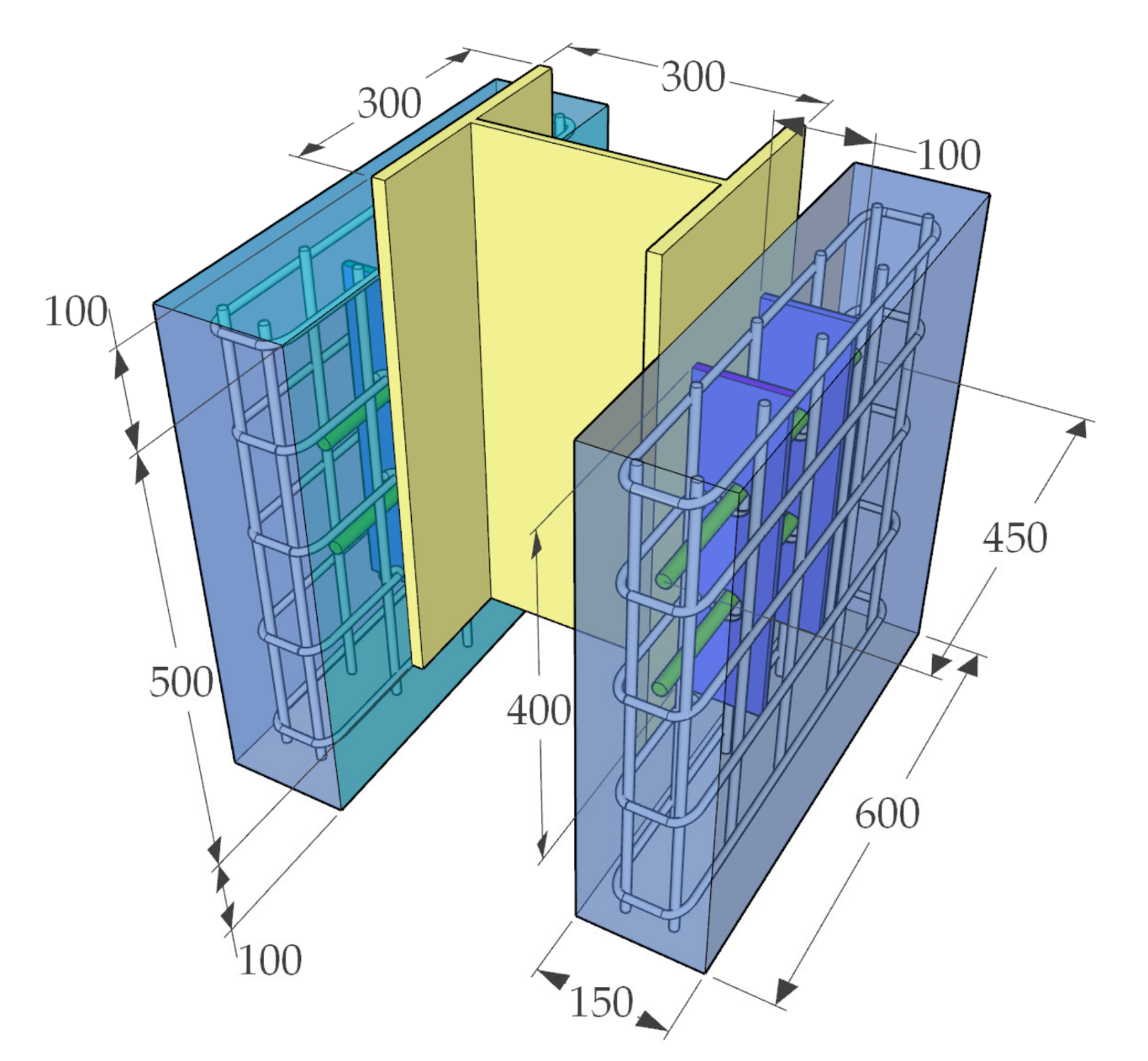

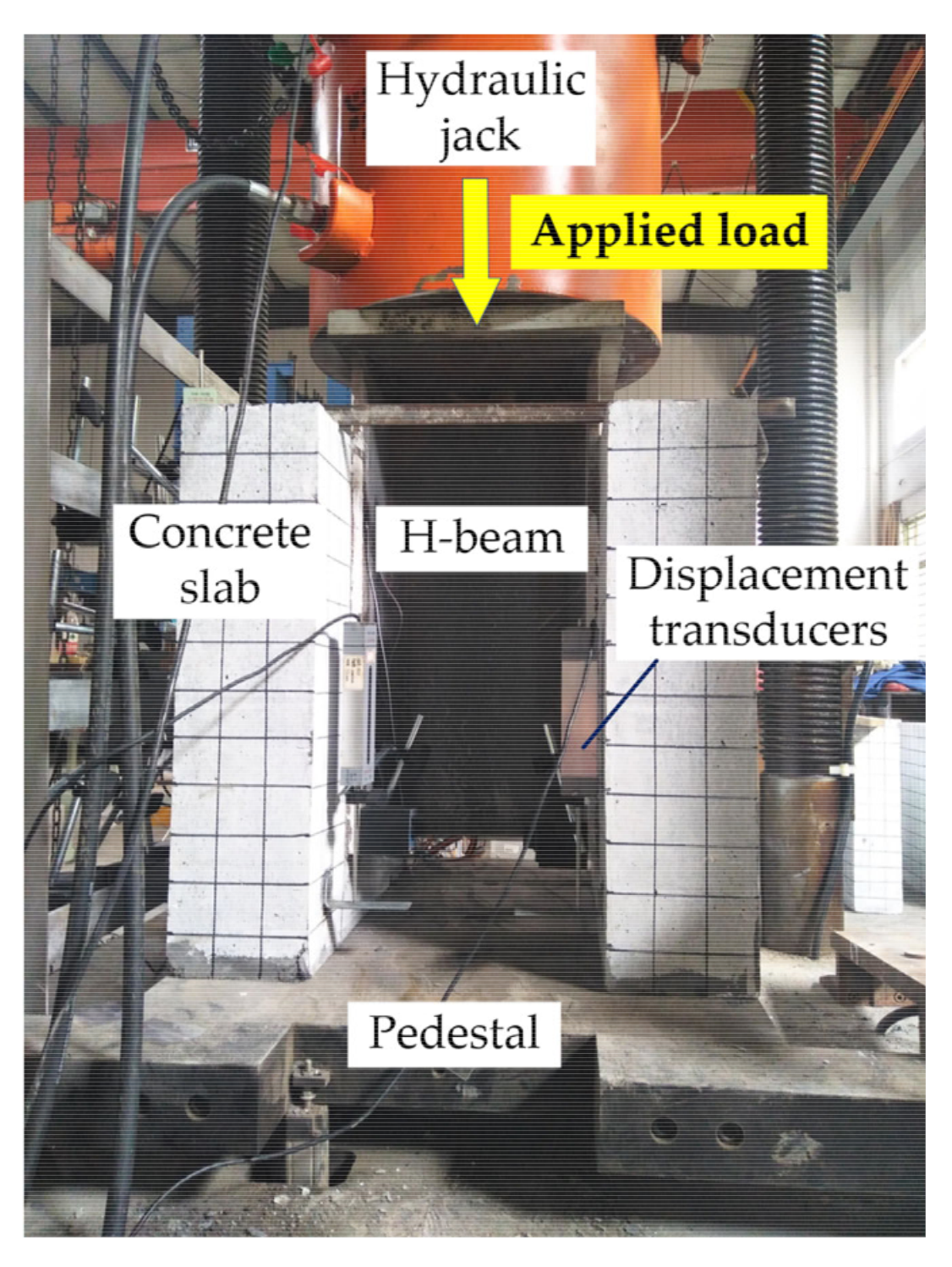
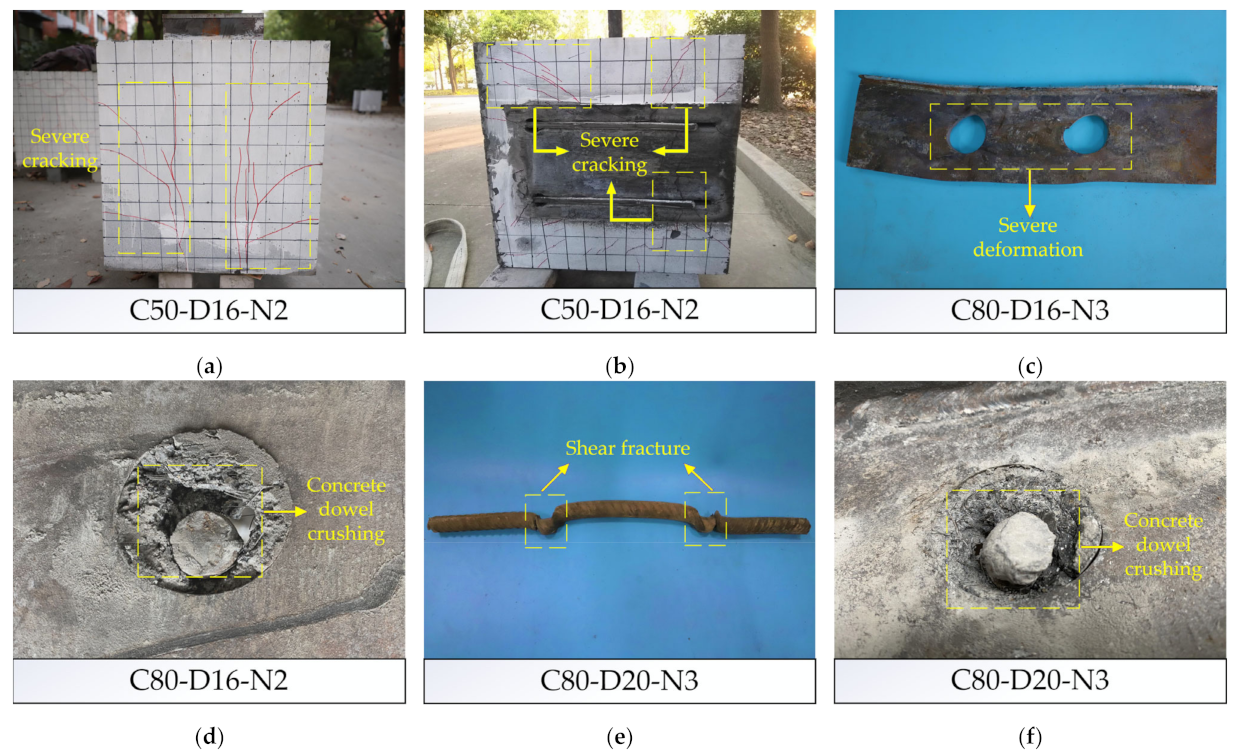
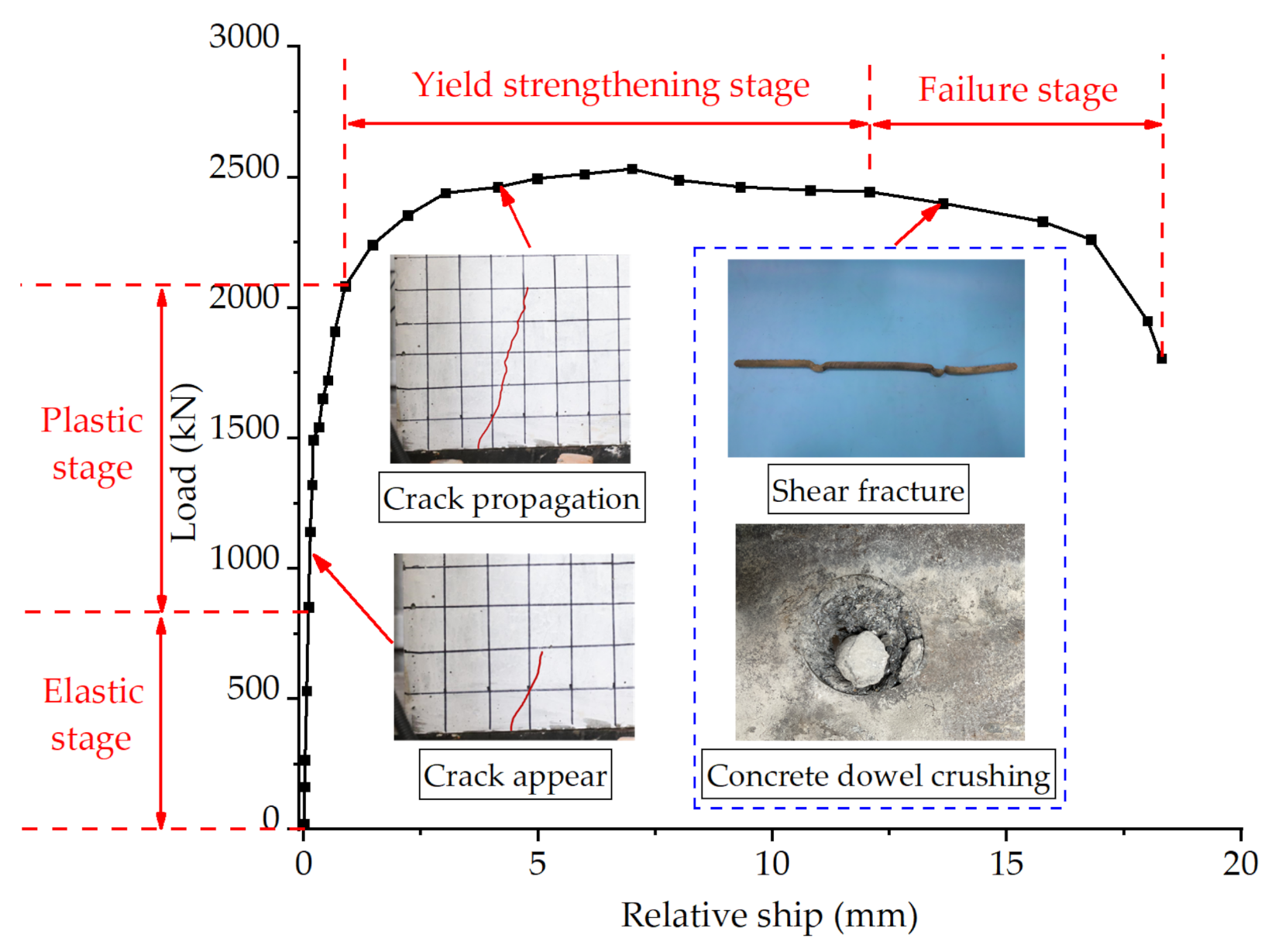
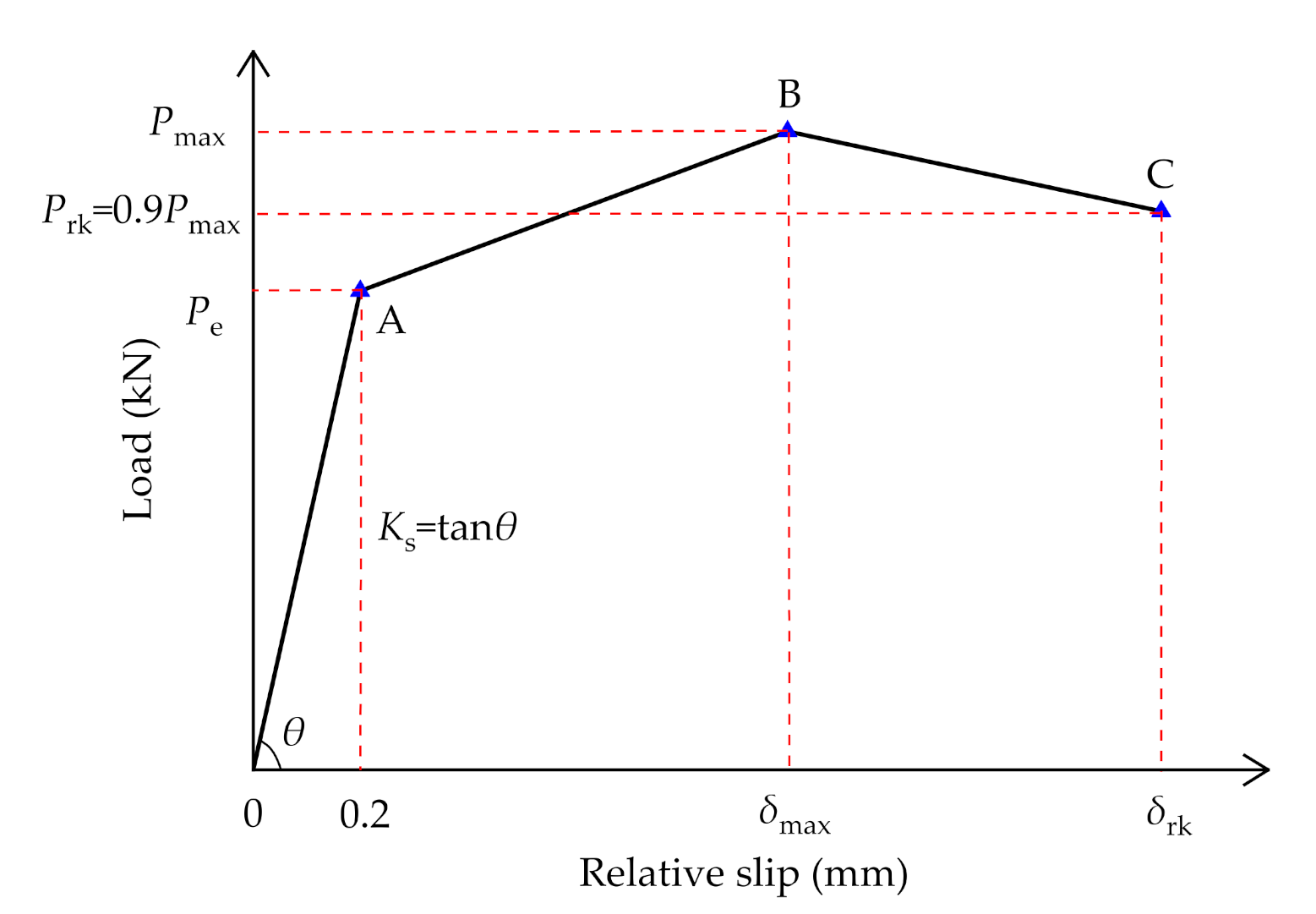
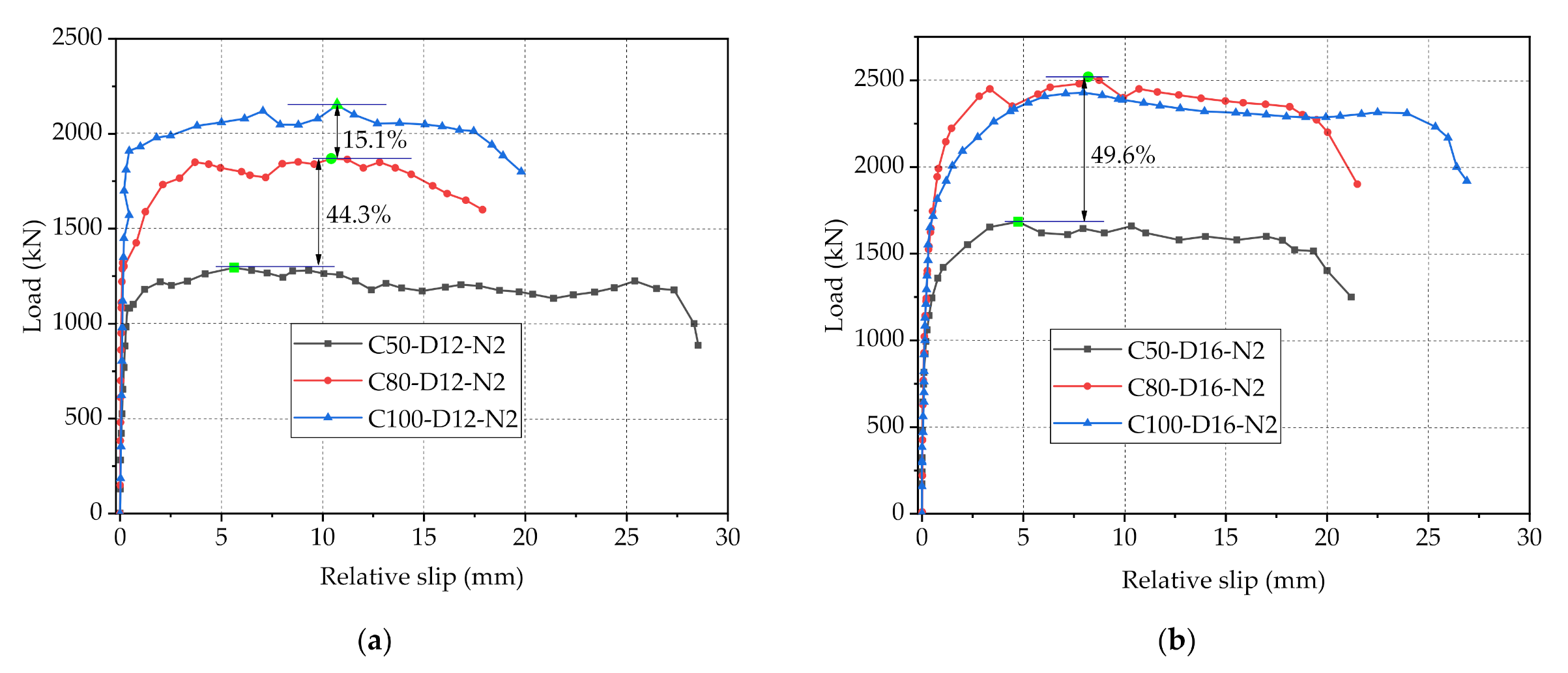
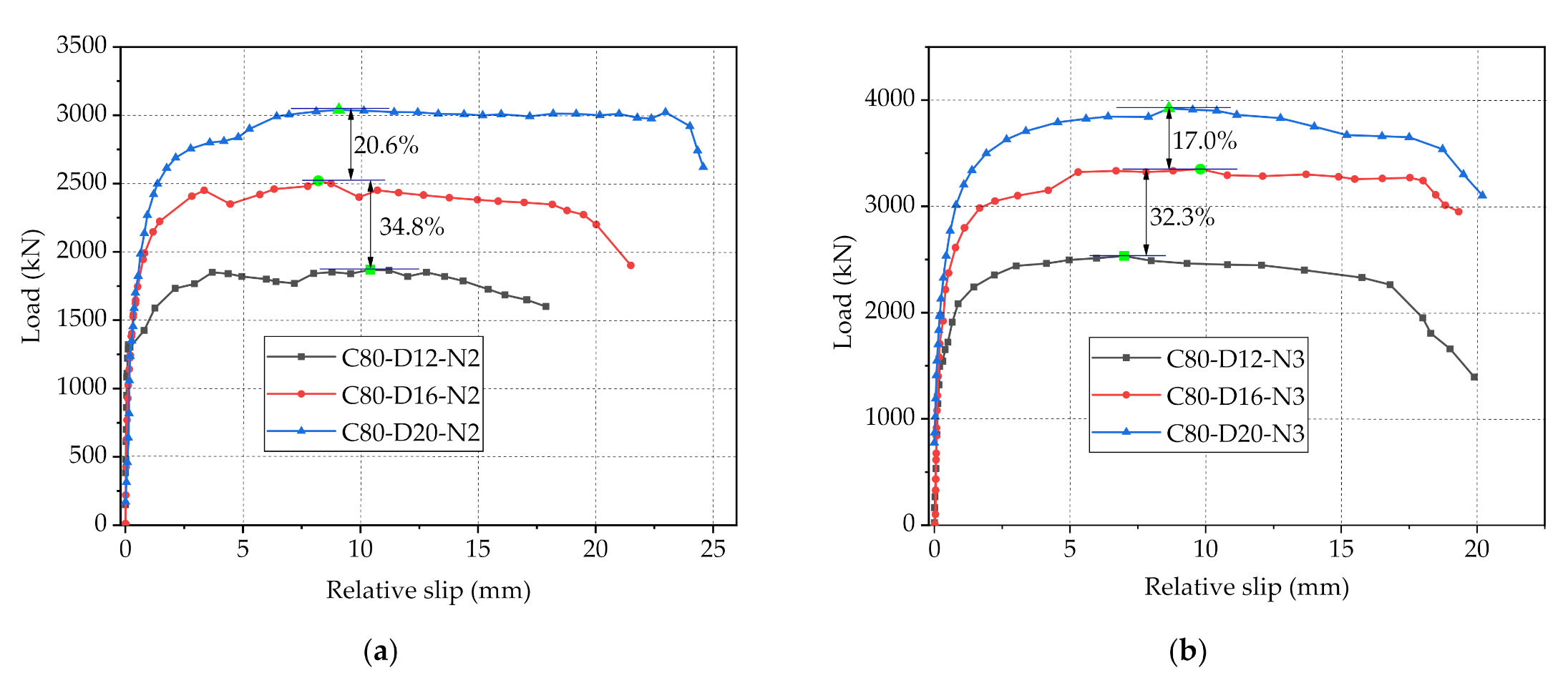
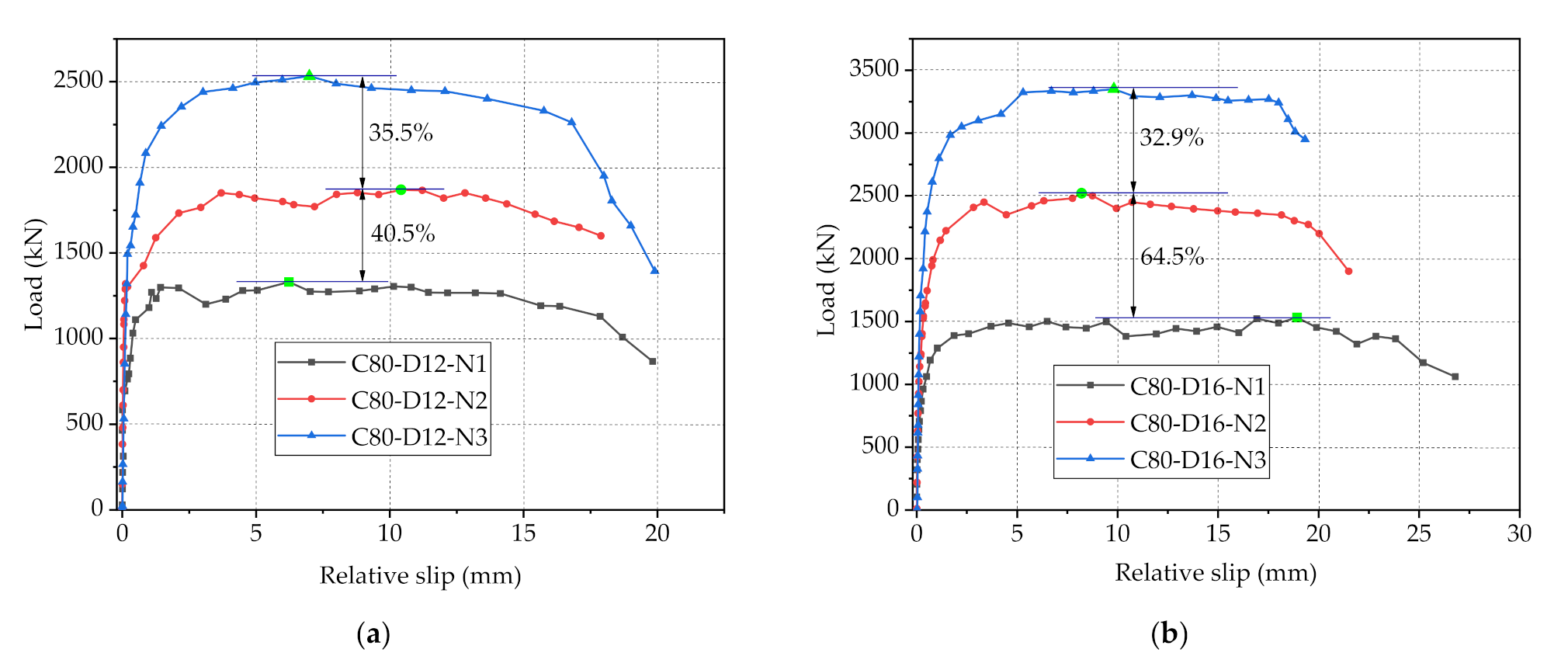
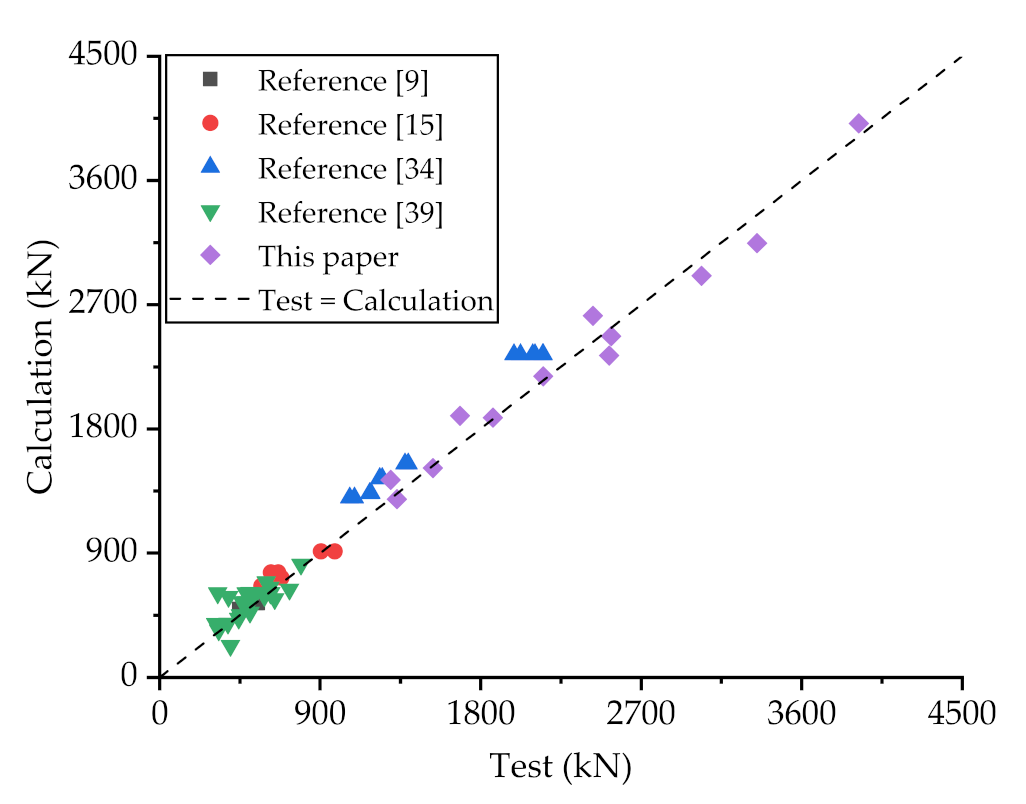
| Specimen Label | Concrete | d (mm) | Perforated Steel Plate (mm) | ||
|---|---|---|---|---|---|
| Nominal Strength (MPa) | fcu (MPa) | Ec (GPa) | |||
| C50-D12-N2 | 50 | 52.3 | 37.5 | 12 |  |
| C50-D16-N2 | 50 | 50.5 | 37.1 | 16 | |
| C80-D12-N1 | 80 | 83.3 | 43.2 | 12 |  |
| C80-D16-N1 | 80 | 82.7 | 42.8 | 16 | |
| C80-D12-N2 | 80 | 81.2 | 43.7 | 12 |  |
| C80-D16-N2 | 80 | 80.3 | 42.5 | 16 | |
| C80-D20-N2 | 80 | 80.9 | 42.8 | 20 | |
| C80-D12-N3 | 80 | 79.8 | 42.1 | 12 |  |
| C80-D16-N3 | 80 | 81.3 | 42.8 | 16 | |
| C80-D20-N3 | 80 | 81.4 | 43.2 | 20 | |
| C100-D12-N2 | 100 | 103.7 | 46.0 | 12 |  |
| C100-D16-N2 | 100 | 104.2 | 46.2 | 16 | |
| Specimen Label | Pmax (kN) | δmax (mm) | Prk (kN) | δrk (mm) | Ks (kN·mm−1) |
|---|---|---|---|---|---|
| C50-D12-N2 | 1295.3 | 5.63 | 1165.8 | 23.42 | 3847.4 |
| C50-D16-N2 | 1684.3 | 4.74 | 1515.9 | 19.33 | 4972.2 |
| C80-D12-N1 | 1330.3 | 6.23 | 1197.3 | 15.65 | 3818.6 |
| C80-D16-N1 | 1532.5 | 18.93 | 1379.3 | 22.86 | 3951.2 |
| C80-D12-N2 | 1868.9 | 10.42 | 1682.0 | 16.15 | 6511.5 |
| C80-D16-N2 | 2520.2 | 8.21 | 2268.2 | 19.49 | 6131.6 |
| C80-D20-N2 | 3038.7 | 9.08 | 2734.8 | 24.34 | 6183.5 |
| C80-D12-N3 | 2532.2 | 6.99 | 2279.0 | 16.80 | 7468.5 |
| C80-D16-N3 | 3350.2 | 9.81 | 3015.2 | 18.83 | 8531.2 |
| C80-D20-N3 | 3920.7 | 8.65 | 3528.6 | 18.73 | 9529.0 |
| C100-D12-N2 | 2150.9 | 10.71 | 1935.8 | 18.35 | 8501.2 |
| C100-D16-N2 | 2429.6 | 7.97 | 2186.6 | 25.98 | 6050.9 |
| Authors | Prediction Equation | Notation | |
|---|---|---|---|
| Oguejiofor and Hosain [8] | (1) | Vu: shear capacity of connector (N) hsc: height of steel plate (mm) tsc: thickness of steel plate (mm) fck: concrete prismatic strength (MPa) fcu: concrete cubic strength (MPa) fy: yield strength of rebar (MPa) Atr: area of rebar (mm2) Ab: contact area between steel plate and concrete (mm2) n: number of holes D: diameter of hole (mm) τb: residual bond stress (MPa) Vf: volume content of steel fibers Lf: length of steel fibers (mm) φf: diameter of steel fibers (mm) | |
| Ahn et al. [34] | (2) | ||
| JTGD64-2015 [35] | (3) | ||
| He et al. [15] | (4) |
| Specimen Label | Vu (kN) | Equation (1) | Equation (2) | Equation (3) | Equation (4) | Equation (20) | |||||
|---|---|---|---|---|---|---|---|---|---|---|---|
| Vcu (kN) | Vcu/Vu | Vcu (kN) | Vcu/Vu | Vcu (kN) | Vcu/Vu | Vcu (kN) | Vcu/Vu | Vcu (kN) | Vcu/Vu | ||
| C50-D12-N2 | 1295.3 | 911.9 | 0.70 | 741.0 | 0.57 | 1080.6 | 0.83 | 652.4 | 0.50 | 1127.4 | 0.87 |
| C50-D16-N2 | 1684.3 | 1168.1 | 0.69 | 1039.4 | 0.62 | 1470.0 | 0.87 | 1236.0 | 0.73 | 1602.0 | 0.95 |
| C80-D12-N1 | 1330.3 | 1068.8 | 0.80 | 763.4 | 0.57 | 686.0 | 0.52 | 483.6 | 0.36 | 1291.8 | 0.97 |
| C80-D16-N1 | 1532.5 | 1196.9 | 0.78 | 912.6 | 0.60 | 869.5 | 0.57 | 769.7 | 0.50 | 1516.5 | 0.99 |
| C80-D12-N2 | 1868.9 | 1233.7 | 0.66 | 955.4 | 0.51 | 1372.0 | 0.73 | 861.8 | 0.46 | 1882.1 | 1.01 |
| C80-D16-N2 | 2520.2 | 1489.8 | 0.59 | 1253.7 | 0.50 | 1739.0 | 0.69 | 1442.0 | 0.57 | 2331.4 | 0.93 |
| C80-D20-N2 | 3038.7 | 1819.2 | 0.60 | 1637.4 | 0.54 | 2211.0 | 0.73 | 2188.0 | 0.72 | 2909.2 | 0.96 |
| C80-D12-N3 | 2532.2 | 1398.5 | 0.55 | 1147.3 | 0.45 | 2057.9 | 0.81 | 1240.0 | 0.49 | 2472.4 | 0.98 |
| C80-D16-N3 | 3350.2 | 1782.7 | 0.53 | 1594.8 | 0.48 | 2608.6 | 0.78 | 2114.4 | 0.63 | 3146.4 | 0.94 |
| C80-D20-N3 | 3920.7 | 2276.7 | 0.58 | 2170.3 | 0.55 | 3316.5 | 0.85 | 3238.5 | 0.83 | 4013.0 | 1.02 |
| C100-D12-N2 | 2150.9 | 1459.7 | 0.68 | 1098.3 | 0.51 | 1576.7 | 0.73 | 888.2 | 0.41 | 2181.2 | 1.01 |
| C100-D16-N2 | 2429.6 | 1715.9 | 0.71 | 1396.6 | 0.57 | 1928.0 | 0.79 | 1466.3 | 0.60 | 2620.0 | 1.08 |
| Average | — | — | 0.66 | — | 0.54 | — | 0.74 | — | 0.57 | — | 0.98 |
Publisher’s Note: MDPI stays neutral with regard to jurisdictional claims in published maps and institutional affiliations. |
© 2021 by the authors. Licensee MDPI, Basel, Switzerland. This article is an open access article distributed under the terms and conditions of the Creative Commons Attribution (CC BY) license (https://creativecommons.org/licenses/by/4.0/).
Share and Cite
Wu, F.; Liu, S.; Xue, C.; Yang, K.; Feng, Y.; Zhang, H. Experimental Study on the Mechanical Properties of Perfobond Rib Shear Connectors with Steel Fiber High Strength Concrete. Materials 2021, 14, 3345. https://doi.org/10.3390/ma14123345
Wu F, Liu S, Xue C, Yang K, Feng Y, Zhang H. Experimental Study on the Mechanical Properties of Perfobond Rib Shear Connectors with Steel Fiber High Strength Concrete. Materials. 2021; 14(12):3345. https://doi.org/10.3390/ma14123345
Chicago/Turabian StyleWu, Fangwen, Shuo Liu, Chengfeng Xue, Kangkang Yang, Yanpeng Feng, and Hao Zhang. 2021. "Experimental Study on the Mechanical Properties of Perfobond Rib Shear Connectors with Steel Fiber High Strength Concrete" Materials 14, no. 12: 3345. https://doi.org/10.3390/ma14123345
APA StyleWu, F., Liu, S., Xue, C., Yang, K., Feng, Y., & Zhang, H. (2021). Experimental Study on the Mechanical Properties of Perfobond Rib Shear Connectors with Steel Fiber High Strength Concrete. Materials, 14(12), 3345. https://doi.org/10.3390/ma14123345






